The year is 2001 and I am training boxers in Bangkok, Thailand. That’s where I meet Pompoi. Unlike his nickname, which means “fatty” in Thai, Pompoi is small, lean, fast, and surprisingly strong for his size. His dream, like many others of his age, is to become pro and fight at the famous Lumpini stadium in Bangkok. He also has a strange particularity, and one that does not serve him well: he cannot stay standing for more than a couple of minutes during a fight. A fast step back, a bit of sweat or blood on the mat, anything is a reason for him to fall. You can be a great athlete and have poor balance. Unfortunately, it is not ideal for an aspiring Muay Thai pro fighter.
As a trainer, some of our most important goals are to help our students move better, move safely, get stronger, and perform better in sports and daily life. None of that can happen without adequate balance which we can optimize with hardstyle kettlebell training.
Even if you don’t remember it, one of the first fears you had as a baby, was the fear of falling. Interestingly enough, it’s also a fear shared by our aging population. Likely so, because falling is not only common, but also potentially disabling for those who don’t recover as quickly as the years pass. Nevertheless, working on balance is useful for everyone, from young to old. Whether one plays any kind of sport or just walks around, if you sit down, stand up, climb stairs, pick up and carry heavy objects, etc., balance is key. Lucky for us, kettlebells prove to be an extremely efficient tool to improve one’s balance, either as a stand-alone tool, or combined with other readily available equipment.
Good balance is often taken for granted. In general, most people don’t find it difficult to walk across a gravel driveway, transition from walking on a sidewalk to grass, or get out of bed in the middle of the night without stumbling. Balance is based on a constant flow of information that the cerebellum in our brain receives from our senses. Of all that input, these three are the most important when it comes to maintaining balance:
- Our vision gives us a constant reference based on fixed (or moving) objects in our surroundings.
- Our vestibular system (motion, equilibrium, spatial orientation) helps us understand which way is up and down, and how fast we are going and accelerating.
- Our proprioception informs the relationship between our body in space and the surrounding environment.
Training Scenario #1: The Ground Is Stable, We Are Not
We are moving on a stable base of support. This is the most typical style of training because that’s what many sports require. We are on stable ground and moving against that stable ground. Any ball game, team sport, or martial art requires a movement-based approach to help the individual control their balance while moving in every direction and plane.
Side-step swing: during the upward movement of the kettlebell of the Swing cycle, the girevik (kettlebell practitioner) takes a step to the right or the left and then steps out, widening their stance for the next eccentric loading phase. This could be a traveling side-step swing (always stepping in the same direction), or you could alternate side-stepping left and right to stay in the same position.
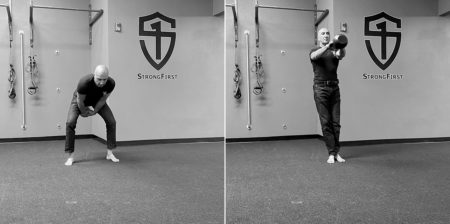
Pull Catch with forward and backward Lunge: during the upward movement of the kettlebell of the Pull Catch, the girevik takes a step forward or backward and then readjusts their stance for the next drop to the floor.
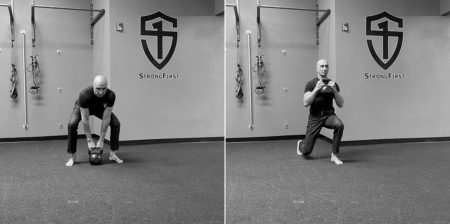
Cross Clean: the kettlebell starts on the ground at the opposite foot from the rack position after the Clean. The girevik grasps the kettlebell with one hand, squares their body to the front, the same side knee rotates to the midline, and the heel comes off the floor, in an Elvis-like knee bend. Once the drive portion of the clean begins, the kettlebell comes up diagonally and into the rack position, both heels are rooted now. The girevik reverses the movement for the eccentric.
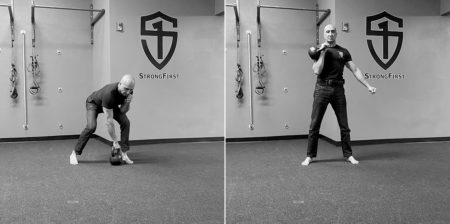
Training Scenario #2; We Are stable, The Ground Is Not
A few years ago, training on unstable surfaces seemed to be the go-to method in the whole fitness industry. Things got crazy and lost touch with reality. The risk to reward ratios became dangerous. There is no need to train double snatches on a BOSU ball. The circumstances where the ground is unstable are pretty limited in daily life and in most sports except some exceptions like water activities (water skiing, surfing), and winter sports (skiing, snowboarding). In daily life, the floor might be slippery or wobbly and we can train that with a few kettlebell drills and some easily available accessories.
Slider compass drill: I learned this drill from Andrea Chang, StrongFirst Certified Master Instructor . The girevik holds a kettlebell in one hand by their side (Farmer Carry position) and puts the ball of the same side foot on a slider. The standing position is the center of the compass. The goal is to reach every cardinal point with the foot on the slider (north, south, east, west, northeast, northwest, etc) while maintaining balance and an upright torso. It’s a great drill for alpine or cross-country skiers or ice skaters.
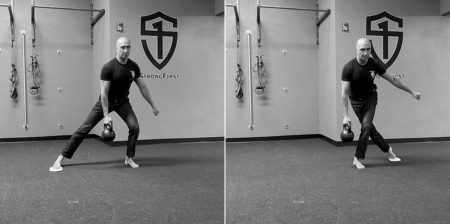
Kettlebell lunge with an inverted half roller: based on a concept presented to me by Katy Bowman (biomechanist and bestselling author of “Move Your DNA”), the girevik holds one kettlebell by their side and places one foot on an inverted half foam roller. It can be the same side foot (ipsilateral loading) or the opposite foot (contralateral loading). The goal is to step back and perform progressively lower back lunges while maintaining balance and a near upright torso.
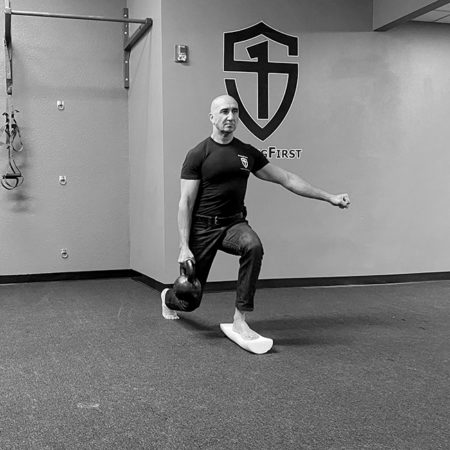
Training Scenario #3: Everything is Stable, but The Ground is Surprisingly Small
In this situation we are dealing with a small base of support. When we are balancing on a small surface like a step or a plank, or more commonly, every time we are on one leg of support, we are forced to integrate our torso and our base of support, improving the reflexive stability between upper and lower body. For instance, this is one way to train people who tend to fall or are unstable when they walk up or down stairs. This type of drill also helps anyone who is interested in lifting (grinds) more efficiently. The adage “you cannot shoot a cannon from a canoe” has never been so true.
Slingshot/around the world: starting in a standing plank position with feet at a comfortable width, the girevik passes a kettlebell from hand to hand, around their body, keeping their torso and shoulders square to the front. Narrowing and widening the stance changes the loading of the body.
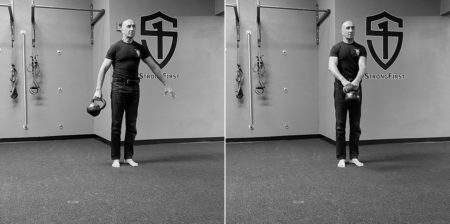
Farmer Carry on a 2×4: a staple of MovNat balance practice, Farmers Carries with one or two kettlebells can be performed while walking on a 2 by 4 beam, or any similar narrow surface. By restricting the width of the gait, the girevik learns to maintain balance under load. Carrying the kettlebell on the side is close to real life and allows the girevik to actually have a visual, if necessary, where they place their feet. The drill can be made more challenging if the kettlebell is carried in the rack position or overhead.
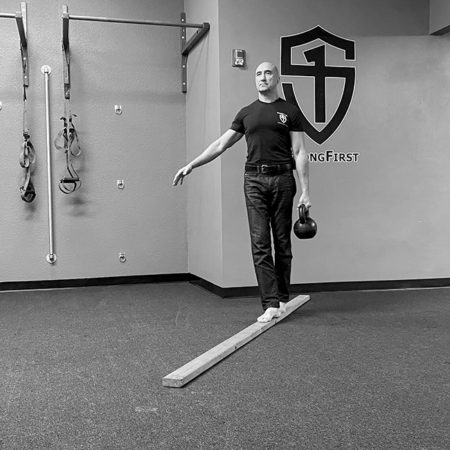
Training Protocol
I noticed that, when it comes to practice, consistency is way more important than quantity. A few minutes of balance training several days a week will bring more results than an hour every two weeks.
This protocol takes 10 minutes and can be done as part of a warm-up before strength practice, or as a stand-alone session every day or every other day:
Training Scenario #3 drills:
- Around the world: 10 reps to the left
- Farmer Carry on a 2×4: 3 lengths (Carry on the right side)
- Around the world: 10 reps to the right
- Farmer Carry on a 2×4: 3 lengths (Carry on the left side)
- Around the world: 10 reps to the left
- Rack Carry on a 2×4 (or Overhead Carry): 2 lengths (Carry on the right side)
- Around the world: 10 reps to the right
- Rack Carry on a 2×4 (or Overhead Carry): 2 lengths (Carry on the left side)
Fast and loose drills
Training Scenarios #1 and #2 drills:
- Side-step Swings: 10 reps, starting on the right
- Slider Compass drill: 1 rep, right foot on slider, reaching for the cardinal points
- Kettlebell Lunges: 5 reps, right foot on an inverted half roller
- Side-step Swings: 10 reps, starting on the left
- Slider Compass drill: 1 rep, left foot on slider, reaching for the cardinal point
- Kettlebell Lunges: 5 reps, left foot on an inverted half roller
Fast and loose drills
- Pull Catch Lunges (or right hand Cross): 10 reps forward
- Slider Compass drill: 1 rep, right foot on slider, reaching for the cardinal points
- Kettlebell Lunges: 5 reps, right foot on an inverted half roller
- Pull Catch Lunges (or left hand Cross): 10 reps backward
- Slider Compass drill: 1 rep, left foot on slider, reaching for the cardinal point
- Kettlebell Lunges: 5 reps, left foot on an inverted half roller
Note: for most of these skills, the kettlebell does not need to be heavy. At the beginning, the challenge does not reside in the weight carried or lifted, but in the static or dynamic positioning of the load and the body. Some of the drills are surprisingly difficult at the beginning, even with a very light kettlebell. Tiny but mighty!
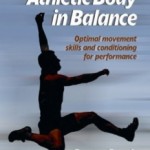
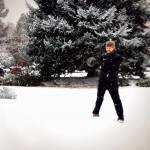

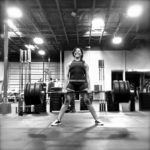


Thank you for those kind words, Jawad.
Yes, the boxer improved his balance. Balance is one of those things that can improve very quickly, but you also need regular practice in order to maintain the skills.
Thanks for the great article and suggestions. Some of the exercises I’ve practiced few times but didn’t know they were helpful in the balance aspect.
By the way, did that boxer improve his balance?
Thanks